President's Message
With this final 2019 issue of our NativeScape, I’d like to thank all our members for their continued support of this superb organization. For 25 years, the knowledge and steadfast commitment to preserving our native plant habitats has never been more evident or meaningful.
As GNPS expands into a state governance structure, it’s important to recognize those before us who built our foundation. Many thousands of volunteers across the decades have contributed to the conservation of native plants – as evidenced in the parks, restoration spaces, through workshops and fieldtrips, plant rescues, as well as their own private spaces that exemplify the passion of our founding members.
 One of the most significant steps we can take in the year ahead is to begin building chapters across the state. Chapters are already beginning inside Atlanta, Athens and the Augusta CSRA (Central Savannah River Area). A CSRA meeting this fall at the Columbia County Library made my heart soar for the many master gardeners, naturalists, and botanists of all ages who want to start a local chapter. This is an important area of opportunity for a forming chapter with our native plant rescue program due to extensive expansion in the county for the Fort Gordon US cyber base. You can contact me directly if you are interested in getting involved for this local chapter development. One of the most significant steps we can take in the year ahead is to begin building chapters across the state. Chapters are already beginning inside Atlanta, Athens and the Augusta CSRA (Central Savannah River Area). A CSRA meeting this fall at the Columbia County Library made my heart soar for the many master gardeners, naturalists, and botanists of all ages who want to start a local chapter. This is an important area of opportunity for a forming chapter with our native plant rescue program due to extensive expansion in the county for the Fort Gordon US cyber base. You can contact me directly if you are interested in getting involved for this local chapter development.
Ellen Honeycutt and Lori Conway, Strategic Planning Committee Chair, led the chapter formation meeting in Dunwoody last month and will continue taking the organization forward next year with upcoming meetings. These important steps will establish new chapters, bridging stronger native plant communities across the state. To learn more on getting involved with chapter development and how GNPS can provide support, visit our FAQs page or email us direct at chapters@gnps.org.
We have exciting events happening inside and outside of Georgia. Ellen Honeycutt, one of our longtime leadership volunteers and past president, will be speaking at the Environmental Education Alliance of Georgia conference in March on the benefits of building native plant awareness through social channel marketing. She’ll also be speaking at the Florida Native Plant Conference in May where native plant societies from Virginia to California will be gathering to increase native plant awareness, strengthen codification, and enrich our bonds throughout the Southeast.
 We’re also looking forward to our 2020 Symposium with keynote speaker Doug Tallamy who will be signing his newly released book, “Nature’s Best Hope: a New Approach to Conservation That Starts in Your Yard.” We’ll have a lineup of speakers supporting this theme, with topics on landscape design, habitat restoration, and building bird and wildlife sanctuaries in our yards. The devastating decline of birds and insects can be significantly lessened by simply planting native plants in our yards. Becky Griffin, UGA Extension School Garden and Pollinator Census Coordinator, shared with us earlier this year that even just a 10’ x 10’ space in each We’re also looking forward to our 2020 Symposium with keynote speaker Doug Tallamy who will be signing his newly released book, “Nature’s Best Hope: a New Approach to Conservation That Starts in Your Yard.” We’ll have a lineup of speakers supporting this theme, with topics on landscape design, habitat restoration, and building bird and wildlife sanctuaries in our yards. The devastating decline of birds and insects can be significantly lessened by simply planting native plants in our yards. Becky Griffin, UGA Extension School Garden and Pollinator Census Coordinator, shared with us earlier this year that even just a 10’ x 10’ space in each  residential yard can help with pollinator health and survival. The majority of urban tree canopy exists on private property, therefore, we as homeowners hold the key to restoring native plant communities. residential yard can help with pollinator health and survival. The majority of urban tree canopy exists on private property, therefore, we as homeowners hold the key to restoring native plant communities.
Finally, I’d also like to acknowledge the environmentalists and botanists we lost this year. Their intellect and love of Georgia native plants inspire us with more resolute purpose to preserve and protect what they held dear and what we are building for tomorrow. Throughout the organization we are surrounded with vast knowledge and passion for our native plants. Take advantage now of this great learning opportunity by volunteering at the Stone Mountain Propagation Project where you can often work alongside Elaine Nash, one of the most knowledgeable botanists and contributing volunteers in the organization. Or join a GNPS Plant Rescue where you learn more about native plants in the field, get to know our expert facilitators, and even take home some plants for your yard or community park as your contribution to restoring bird and insect populations.
It’s been a profound privilege to serve with the many volunteers of this wonderful organization. I’d like to express my immense gratitude to each and every one of you for being a part of this journey we all share – to love and care, with gratitude for our beautiful Earth.
Melanie Bass Pollard
GNPS President 2019
Strategic Planning Task Force Farewell and Thank You’s
Lori Conway
The Strategic Planning Task Force’s job is done. With the November 12, 2019, unanimous member vote to accept our bylaw changes and elect our first state governing board, we set the stage for great things to come, paving the way for more hands to become involved in our mission to promote the use and conservation of Georgia’s many wonderful native plants. That we were able to clear this hurdle in a relatively short time was due to firm groundwork laid and vision shared by previous boards and members, as far back as our founding in 1994, along with some very timely outside help from two wonderful people.
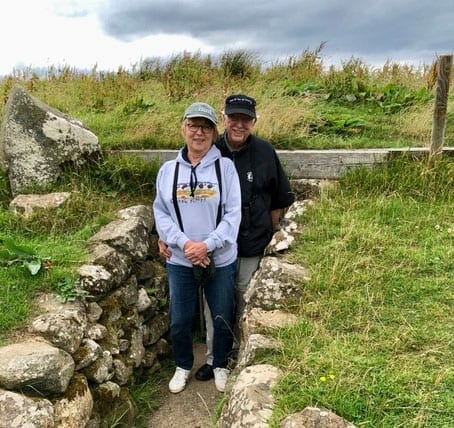
Linda DiSantis and Bob Kerr, shown here on a visit to Scotland, have been a key part of the Strategic Planning Task Force.
I would like to acknowledge the tremendous contributions of Linda K. DiSantis, retired attorney and past Board Chair of Atlanta Audubon Society and her husband, Bob Kerr, who among his many conservation accomplishments served as Executive Director of the Georgia Conservancy. They both graciously guided us to this point, but Linda especially donated many hours of her personal time for well over a year in revising our bylaws, attending numerous meetings and answering countless questions. Both Linda and Bob provided wise counsel along the way based on their experience with growing Atlanta Audubon and other conservation organizations. We are forever indebted to them. Linda has graciously added her own perspective: “We both want your members to know how glad we were to work with the dedicated members of the board and the Task Force. What GNPS has accomplished is a big step forward that required hard work by a lot of people. We are happy we could help, and we wish GNPS good luck as you move forward.” To honor the selfless donation of Linda and Bob, we must continue to grow and ensure GNPS becomes an equal partner the statewide conservation network that is vital to the future of our natural world.
I’d also like to take a moment to recognize my fellow task force members: Lane Conville-Canney, Past Board Member and President, and Kate Baltzell, Past Board Member and Secretary, for laying the groundwork late last fall on the Task Force and continuing as advisers this year; Florence Hayes, West Georgia Chapter President, who brought her down-to-earth chapter perspective to everything we considered; Ellen Honeycutt, 2019 Membership Director, whose significant past GNPS board service helped us craft our forward vision and recruit our state board; and Henning Von Schmeling, 2019 Co-Conservation Director, whose vast experience with non-profits and conservation helped us see the vision for making GNPS a high-functioning organization. Finally, Melanie Bass Pollard, 2019 GNPS President, deserves special acknowledgement for her commitment to the new vision for GNPS and her willingness to serve as president at a most difficult time, when the GNPS board was trying both to serve the immediate needs of the numerous Atlanta area members and act as visionary for the state, all while commuting between Atlanta and her new home in Augusta for both Society and Task Force meetings. Melanie, we are sincerely grateful for your service.
Membership Renewals
Ellen Honeycutt
Thank you for being a member of GNPS. As 2019 comes to a close, we have exciting changes ahead for the Society. Members are gathering throughout the state to form new chapters as well as to participate in activities in existing chapters. With the election of our new state board, we are looking forward to thinking strategically while supporting the boots on the ground activities of our chapters. We hope that each of you will continue to join us in our efforts to promote native plants through education and conservation throughout the state of Georgia.
Renewal reminders will begin this month for members whose membership expires at the end of 2019. If your membership is up for renewal, you’ll get an email from us as a reminder and with a link to the membership page. If you use your GNPS login on the website, your name and address details will be auto-populated for you and you need only provide payment details. Some of you have chosen the auto-renew option; you will get a reminder in late December that your membership is about to renew, before the renewal actually takes place.
Whether your membership is up for renewal or not, extra donations towards our mission are welcome. A direct online donation form can be found here. Or contact your local chapter leadership and donate to GNPS efforts at a more local level.
At any time, members can login to their account on the GNPS website to check the status of their membership. Renewals made in December will be good through all of 2020 (our membership period is Jan-Dec). Again, thank you for being a member and for supporting our mission. If you’re not already an active volunteer, we’d love to have you participate more. Volunteer positions are available at all levels of knowledge and you are sure to learn more by doing! If you have any questions about your membership or would like to volunteer more, reach out to me at ellenhoneycutt@gnps.org.
Chapter News: West Georgia
Florence Hayes
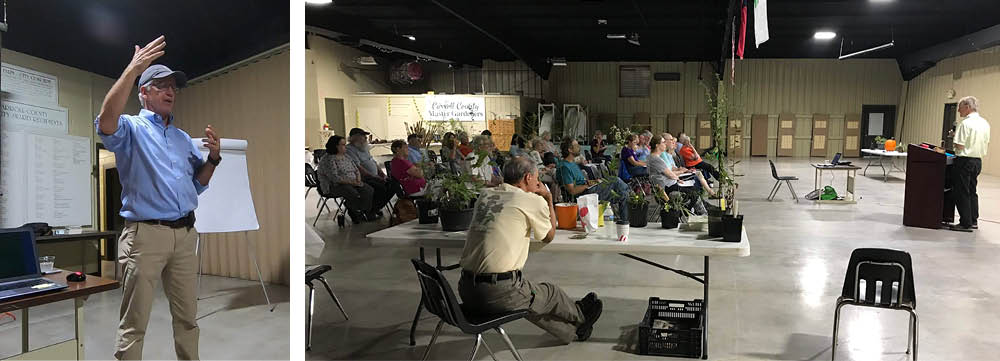
Recent West Georgia Chapter programs have included Walter Bland (left) and Jim Ozier (right). Walter discussed the uses of native grasses in the landscape at the October program, and Jim described conservation efforts for the Georgia Aster statewide by Georgia Power at the West Georgia Fall Workshop.
Over 10 years ago, a group of GNPS members who lived in the Carroll County area met and decided to pursue becoming a GNPS chapter. We all were happy with GNPS, but found driving to Atlanta for meetings and other GNPS activities was time consuming and sometimes difficult. So began the process of chapter formation. As I look back at the first efforts and look at where we are today, I am in awe. We are still going strong We are involved in education, restoration and rescue. As you will read below, WGC-GNPS remains active and strong.
We are very involved in our restoration project, Buffalo Creek Trails. This project is near and dear to our hearts. Gina Strickland reminded me our original focus was about one acre in what we call the Upper Woodlands area. Our aim was to remove the non-native invasive plants and replace them with natives suitable to that habitat. Over the 10 years we have worked on Buffalo Creek Trails, we have expanded from that modest goal, now including about 20 of the 40 acres that comprise the Trails. We have rescued plants for Buff Creek (as we call it). We have bought native plants with grants and fund raisers. Some of our members have propagated plants. We have had donations of plants from Stone Mountain Propagation Project as well as individual GNPS members. We have had donations from unsold plants from plant sales. The list goes on. We are so grateful for all of those plants.
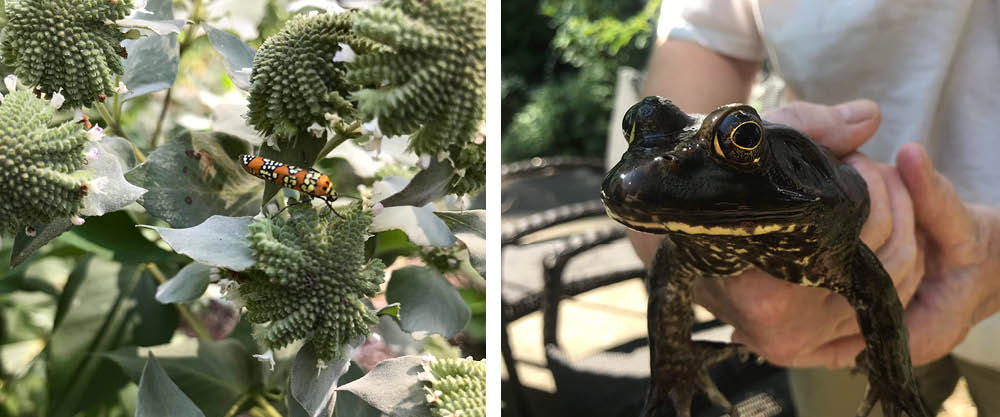
Left: Participants in the statewide Pollinator Count observed insect activity on mountain mint (GNPS Plant of the Year) at Buffalo Creek. Right: A hefty bullfrog becomes another wildlife addition to Buffalo Creek.
We have installed a boardwalk with plans to expand that walkway at some point. We have some split rail fencing with plans to add more. One of our members made and donated a metal buffalo which is installed at our meadow area entrance at the Carrollton GreenBelt walking trail. The GreenBelt was built by the county and plans are to cover 18 miles around the city of Carrollton.
We have many organizations who have sent members to volunteer on the trails, including several garden clubs, businesses, college student organizations, scout programs, Carroll County Master Gardeners and other individuals who "just want to help." We also have county support and often have inmate crews assigned to assist our work. Again, if I have not listed or acknowledged an organization, I apologize. We are grateful for any and all help on this project.
We have procured some rescue sites in our area over the years and currently have two active sites. We have several members who are facilitators and we do our best to rescue as often as possible. This program is so worthy, and when you see people walking Buff Creek trails and commenting on the plants, it is truly heartwarming. The American beautyberry bloomed and set berries. So many folks commented they had never seen this plant before. We continue to look for properties in our area.
We use our public meetings to offer interesting and educational programs We recently had Walter Bland speak to us about native grasses. The program was a success. The interest in native plants seems to be on the rise and the public is hungry for information. We involved ourselves in the Great Pollinator Count and had members of the public come and do counts along side our members. It was rewarding to see these members of the public so interested in this project.

Left: The August rescue at Richland Creek took place just below the dam site of the future reservoir in Paulding County. Right: Carol Hight collects plants along the banks of Richland Creek during the rescue.
Our fall workshop on asters was a success. Ellen Honeycutt spoke on native asters in Georgia. Her talk was wonderful, and I know I left with a desire to have more varieties of asters in my yard. How easy it is to focus so much on the Georgia aster and forget all the other aster natives that deserve our attention. Jim Ozier also spoke at the workshop on Georgia Power's commitment to using their resources and land to help with plant conservation efforts including Georgia asters. It was wonderful to hear that a company is committing resources to this worthy effort. We have members who work with school and children's projects to present programs on native plants. We are involved in Heritage Days in our area which involves all 3rd grade children. It is part of the school program and we have an opportunity to educate about 1500 students on native plants. We have been asked to teach new Master Gardeners about native plants. Some of our members are involved in public speaking at garden clubs and other organizations when asked. We do our best to stay in the public eye, be available and provide a resource for native plant information.
My heart is gladdened to think back on our initial meetings when we were trying to organize and know what we have accomplished in the years since. When folks have a passion and love, it is not hard to accomplish great things. In the beginning we had no money, no name and no place to call home. That did not stop us.
GNPS is in the process of making itself a truly statewide organization. The groundwork has been laid, the by-laws adopted and a slate for the new state Board of Directors is in place. We are positioning ourselves to have the state of Georgia covered with chapters. From my experience with West Georgia Chapter of GNPS, I feel strongly this new direction will strengthen GNPS organization and further GNPS's mission. Forming a chapter is not hard or scary.
May you each find that one native plant you really, really want and may it thrive in your tender loving care.
Plant Spotlight: The Cedar That Isn’t — Juniperus virginiana
Ellen Honeycutt
Early winter is a great time for noticing and appreciating one fantastic native tree, an evergreen known as redcedar. Although it is in the family Cupressaceae, which includes cedar, this particular plant is a juniper. In mid to northern Georgia, the plant is Juniperus virginiana var. virginiana (Eastern redcedar), while in the lower Coastal Plain it is Juniperus virginiana var. silicicola (Southern or Coastal redcedar), where it can withstand growing even in brackish marshes.
This adaptable species is often disparaged for its ability to pop up in fields and roadsides as well as its host relationship to the cedar fungal rust diseases that affect apples, crabapples, and hawthorns. However, its support for wildlife is fantastic, and man has learned to take advantage of its good qualities such its evergreen foliage, its hard and fragrant wood, and its usefulness in holiday decorations (it is grown as a type of Christmas tree).
I recently visited Jekyll Island on the maritime coast of Georgia. The abundance of Southern redcedar was amazing – from roadsides to marshes to maritime forests! Female trees were loaded with blue fruits, ready to nourish migrating and resident birds through the winter. Juniperus virginiana is a dioecious species, bearing male and female cones on different plants. While the “fruits” of redcedar look like berries, they are actually modified seed cones whose scales have fused together.
The Cedar waxwing is a species of migrating bird known for enjoying these fruits and takes its common name from that relationship. Other birds eat the fruits as well and many more use it for shelter. The Juniper hairstreak butterfly uses Juniperus as a host plant. Humans often use it for a bit of privacy from close neighbors as well as winter decoration. The Georgia Forestry Commission sells seedlings to tree farms to grow as Christmas trees.
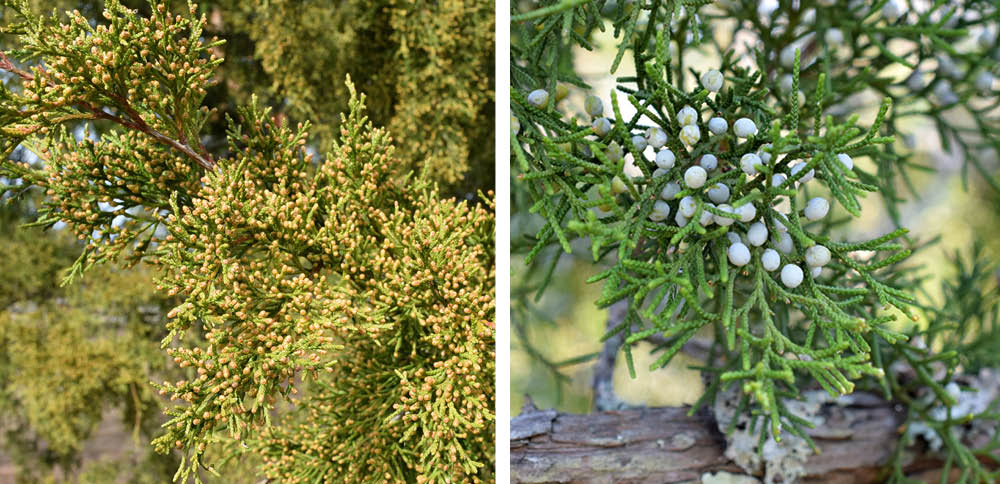
Cones (left) and fruit (right) of redcedar (Juniperus virginiana).
A few final observations of redcedar for identification purposes include the look of the foliage and the reproductive cones. Juniperus virginiana can have both juvenile and mature foliage. Juvenile foliage is sharp and needle-like while mature foliage is tightly adpressed and scale-like and both can be on the plant at the same time. In the winter, brown cones will appear on both female and male trees; the tiny cones can be so numerous that the entire plant takes on a bronze hue. The cones are wind-pollinated so expect that pollen will be released in late winter.
Heggie’s Rock Field Trip
Tom Collins
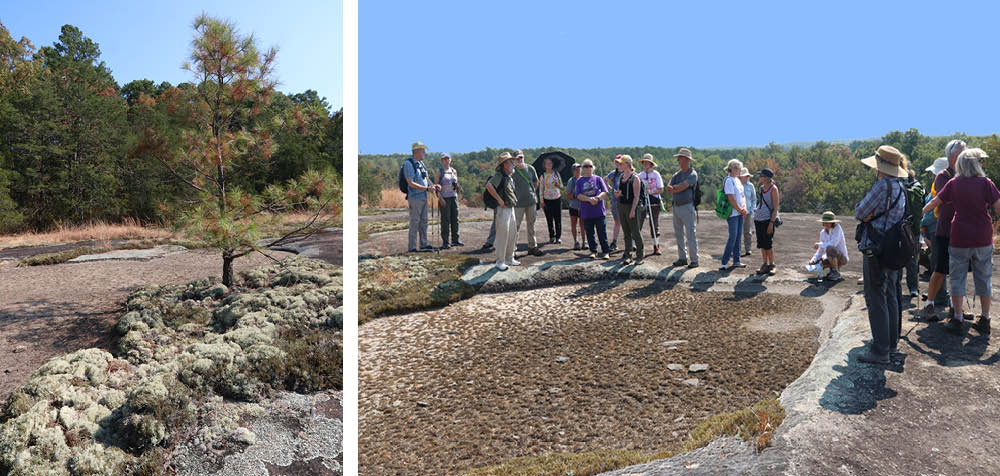
Left: A typical Heggie's Rock vista, replete with mats of lichens and mosses interspersed with rock and vernal pools. Right: The group pauses to learn about mat-forming quillwort (Isoetes tegetiformans) at this site of the largest protected population.
On September 28, over 20 GNPS members were treated to a guided tour of a protected Georgia treasure and designated National Natural Landmark, Heggie’s Rock. Our guide was Malcolm Hodges of The Nature Conservancy, a well-known ecologist and expert in lichens who is familiar with every aspect of the area dominated by the Piedmont flat rock outcrop known as Heggie’s Rock, which is only accessible to the public through supervised tours like ours. As mentioned in the October newsletter, it was only because the Pollard family sold the land to the Conservancy that the site is now protected.
To those of us from the metropolitan Atlanta area, Heggie’s Rock is reminiscent of the familiar string of local granite outcrops that include Stone Mountain and Arabia Mountain, but for every similarity, there are differences. Heggie’s has similar exfoliating rocks, the mosses and lichens that cling to them, the pockets of Diamorpha and other plants that live only in the shallow soil pockets of this habitat, and the surrounding areas that support vascular plants. Among the familiar were blooming yellow daisies (Helianthus porteri), and a surrounding forest of shortleaf pine (Pinus echinata) with mixed oaks and hickories.
But because of its location near Appling, Heggie’s Rock is more southerly, more coastal, and lower in elevation than its metro cousins. And our visit caught the Rock at a particularly dry time, in the midst of the same southeastern drought that all of us have been experiencing. The plants of this landscape are uniquely adapted to harshness, though. Shortly after reaching the first rocky areas, Malcolm demonstrated the resilient and opportunistic nature of moss. When only a trickle of drinking water was dribbled across the parched brown foliage of resurrection moss (Grimmia laevigata), it greened up in seconds. But even in the dry conditions, the mats and islands of vegetation were lush compared to more heavily trafficked Piedmont rock outcrops that do not benefit from the protection that the Conservancy offers to Heggie’s Rock.

Left: A mixture of two reindeer lichens, Cladonia rangiferina (whiter) and Cladonia subtenuis (greener) Right: Malcolm Hodges demonstrates that this spikemoss mat (Selaginella sp.) has virtually no physical attachment to the underlying rock. Do not attempt this with mosses and lichens yourself — Malcolm is an expert!
We continued to an overlook where the stream below provided beavers with habitat, and the not-too-distant sounds of industry were evident. This quarrying for ordinary aggregate materials has threatened Heggie’s Rock, and a more serious peril may be the westward expansion of Augusta, with increasing demand for development. Juxtaposed against this increasing human presence was the threatened plant we encountered on our next stop, only a few yards away. The mat-forming quillwort (Isoetes tegetiformans) is endemic to Georgia, and we were looking at the only protected population, with only a few other nearby sites holding more vulnerable populations. In a dormant state during summer, the quillwort was shriveled and inconspicuous, but when fall and winter bring rains that fill the pool, this aquatic plant will quickly sprout new foliage. As a GNPS member, consider how you also can bring new life to plants. Ensure the protection of Heggie’s Rock flora and other threatened species through GNPS programs as well as those of The Nature Conservancy and our other partners.
GNPS State Board and Chapters: The Future
The new bylaws for the Society were approved at our Annual Business Meeting on November 12, 2019. We are now positioned for State Board governance, easier chapter formation, electronic member voting, and other changes that bring us into a firm and forward position for non-profit governance. You can find a copy of those bylaws on the website.
What’s next? We need enthusiasm and working hands throughout the state to set our direction, form new chapters, and continue the work of educating and promoting use and conservation of Georgia’s native plants. We’ve prepared several resources to help you better understand the changes and how you can help move us forward.
Grass Roots Involvement: The Chapters
This News post on the website provides details and resources for chapter development, particularly in the Atlanta area which needs chapter formation to keep current area activities organized and growing. Several folks are already working to schedule some educational meetings in 2020; meetings are being planned for January (Alpharetta) and March (Dunwoody), and planning is well under way for the Atlanta spring plant sale on April 18. If you’d like to help plan activities and shape where the new chapters might form, email the team at chapters@gnps.org.
State-Level Involvement: The Board and Committees
Members at the November meeting also elected the slate of new State Board directors, listed alphabetically below.
- Michele Buchanan
- Tom Collins
- Lori Conway
- Leslie Edwards
- Amy Heidt
- Ellen Honeycutt
- Marc LaFountain
- Ron Smith
- Henning von Schmeling
The State Board will bolster and craft new strategic partnerships throughout the state. The Directors will form six committees: Education, Conservation, Membership, Finance, Audit, and Governance. Through the work of these committees and working extensively with the chapters, the state board will set policies and goals, which each chapter will implement. We need many Society members from around the state to serve on these committees. This will ensure statewide voices are represented and cohesive statewide policies are adopted to best serve our members and native plant habitats. Read more at our FAQ page regarding state vs. chapter activities.
We look forward to working with you all in 2020 as we step into our new roles. We appreciate any amount of time and talent you can give, either at the chapter or state level. Reach out to the new board by emailing board@gnps.org.
The State Board will elect its officers at the first meeting, and we will announce those immediately. Work is already ongoing to transition duties from the previous board structure to the new one. In the meantime, we will communicate regularly on the progress and activities. You can also check the website for news and the calendar for events around the state. Follow us and our chapter pages on Facebook, Instagram, and Twitter.
|